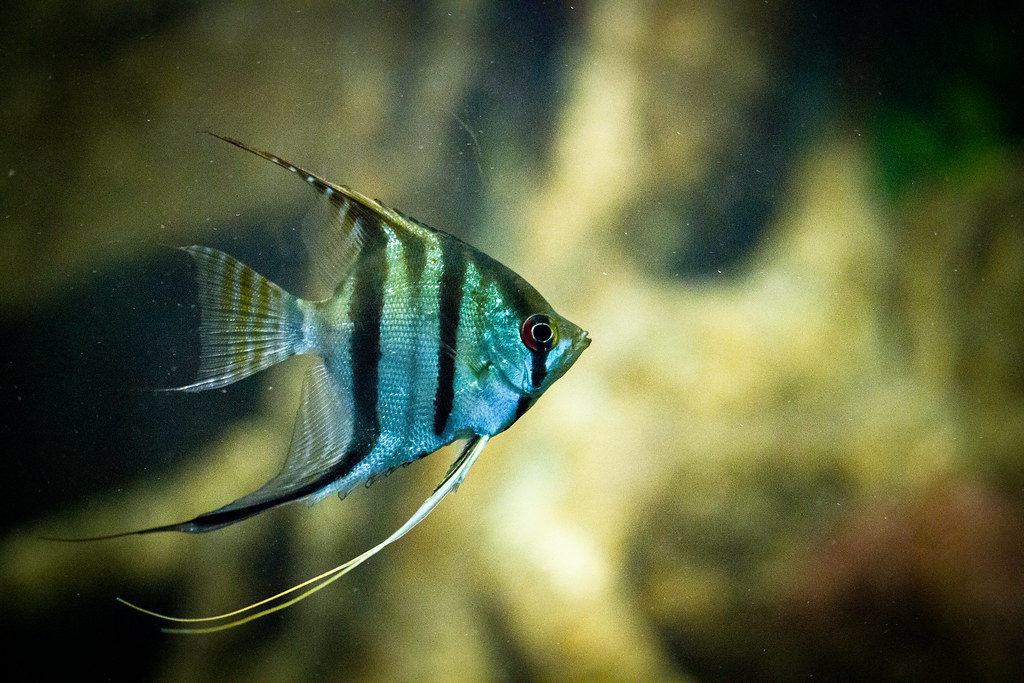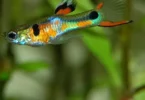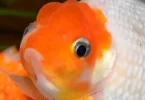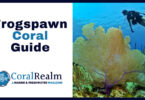Last Updated on February 10, 2023 by Matt
Angelfish, scientifically known as Pterophyllum, are freshwater fish from the Cichlidae family that originate from various rivers in South America such as the Amazon and Orinoco Basin. In the wild they are found in slow flowing water that is shaded by trees and vegetation, creating a low light; making them great for planted aquariums.
In these areas the water is usually acidic and has a reduced water hardness, however this doesn’t mean this is the exact requirement they need in captivity. There is often confusion between saltwater marine angelfish and freshwater tropical angelfish, marine angelfish are physically very different and are usually blue and yellow in color. In this article, we will be discussing the care requirements of tropical freshwater angelfish.
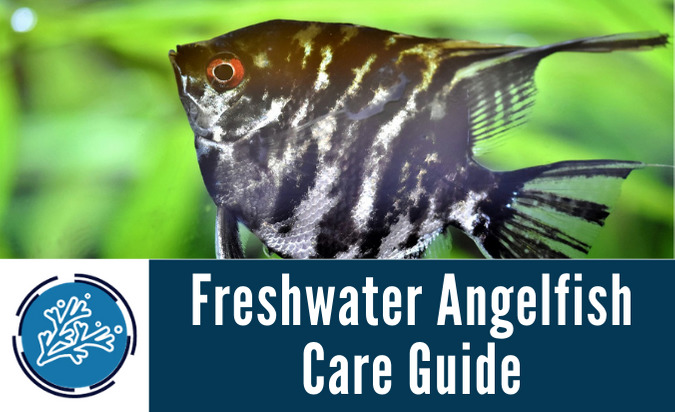
Angelfish Care Summary | |
| Family | Cichlidae |
| Care level | Easy/intermediate |
| Temperament | Semi aggressive |
| Lifespan | 6-10 years |
| Size | 5-7 inches |
| Color | Various colors |
| Diet | Omnivore |
| Minimum tank size | 20 gallons |
| pH levels | 6 – 8 |
| Water hardness | 3-8 dKH (54 to 145 ppm) |
| Temperature range | 75°F – 82°F |
| Compatibility | Peaceful fish, other angelfish |
| Tank set up | Tropical tank with fine substrate |
IN THIS ARTICLE
Appearance
Wild freshwater angelfish are silver with black stripes, whereas captive angelfish have developed a variety of colors, patterns and fins through selective breeding. These colors can include black, pearl, blue, white and patterned, making them a beautiful statement fish for an aquarium. They have thin body shapes that are round compressed with long dorsal and anal fins, this allows them to fit into small gaps and camouflage themselves between objects. In the wild this allows them to hide from predators and also catch small prey without being seen.
Angelfish are usually sold as juveniles when they are only small, but as many beginner fish keepers don’t know, they can grow very large, sometimes up to 12 inches long. However, the most common size for them to grow to as a full sized adult is around 5-7 inches in length. In captivity they live around 5-8 years, but it is not uncommon for them to live till 10 years when kept in the ideal environment of correct water conditions and a good amount of food, that enables them to thrive.
Are angelfish peaceful or aggressive?
Angelfish are a territorial species, and are labelled as semi-aggressive due to the chasing behaviors they carry out in the aquarium when housed with other angelfish. This is often between males when competing for a female or when defending their eggs from other fish if you are breeding them. Even though this occurs they will still thrive in a large tank with a large group of angelfish together, and compared to other cichlids, they are relatively peaceful fish and will live well with other compatible species.
Housing:
Angelfish can be pretty versatile when it comes to a tank set up, and they will happily live in any sort of aquarium; however they do have some preferences that will make them happy and healthy. Regarding aquarium plants, having lots of live plants is not a necessity; however planted tanks are a great option to keep your aquarium looking full of life, and angelfish will often interact with the plants and lay eggs on them when breeding.
Angelfish will happily live in a bare tank set up, but we always advise adding some easy aquatic plants to remove toxic waste compounds and add versatility to your aquarium. Java fern is a great plant to add into your angelfish tank with its broad leaves and height.
The size of the tank depends on how many angelfish you are planning to keep, a pair of angelfish will need a minimum of 20 gallons and a group will need at least 80 gallons. You will then need to add at least 10 gallons onto this for every other angelfish you add to the tank. Angelfish can be pretty adaptable to tank sizes, as long as you don’t overcrowd them with too many fish. Angelfish can also be kept in an aquarium alone or with other compatible species, and in our experience keeping them alone does not affect their well-being all that much.
If you are looking to house a large number of angelfish together, make sure that the number of water changes per month are increased, as the more crowded the angelfish are the dirtier the water will get; doing frequent water changes will keep the water quality high. Water changes can be made easier using a product like the Python water changer.
Water conditions and temperature
Captive bred angelfish are versatile when it comes to water temperature and pH, although they generally prefer warmer temperatures between 75℉-82℉ (23℃-27℃), and they can also be kept at around 86℉ (30℃). To provide these water temperatures you will need to install a high quality heater in the aquarium, either a submerged heater that is attached to the back of the tank or an in-line heater that heats the water up as it travels into the aquarium from the aquarium filter. Heaters need to be installed alongside a thermometer in order for you to monitor the temperature or change it where necessary. Thermometers come in a few different types and sizes, including a separate thermometer to be attached to the glass of the tank or one that is attached to your heater.
Angelfish are not sensitive to pH and can be kept anywhere between 6.0 – 8.0, however a neutral pH of 7 is the best option on the scale – the pH in an Angelfish tank usually depends on the requirements for any other fish that’s in their enclosure. Regarding carbonate water hardness, captive bred angelfish require between 3-8 dKH (54 to 145 ppm).
Wild caught angelfish are more demanding of their water conditions and require soft water with a lower pH for breeding.
To ensure the water parameters at a safe level to prevent your angelfish from becoming sick, we always recommend to test your water at least once every two months to monitor the levels. We always recommend the same two methods using either test strips or a chemical test kit as they are the most reliable:
Aquarium test strips
These water test strips are a quick and easy alternative to the master test chemical kits, complete with four strips and a chemical chart. One of these strips is to be placed into the water for a short amount of time and the colors on the strip should then be compared to the color chart – this will then accurately tell you the levels of pH, nitrite, nitrate, carbonate and general water hardness.
Master test kit
- Contains one (1) API FRESHWATER MASTER TEST KIT 800-Test Freshwater Aquarium Water Master Test Kit, including 7 bottles of testing solutions, 1 color card and 4 tubes with cap
- Helps monitor water quality and prevent invisible water problems that can be harmful to fish and cause fish loss
- Accurately monitors 5 most vital water parameters levels in freshwater aquariums: pH, high range pH, ammonia, nitrite, nitrate
- Designed for use in freshwater aquariums only
- Use for weekly monitoring and when water or fish problems appear
This master kit is a more advanced alternative to the testing strips, with 7 bottles of testing solutions, 1 color card and 4 glass tubes. This kit will measure the pH, high range pH, ammonia, nitrite and nitrate, this kit may give you a more accurate result, however there is more of a risk of disrupting the process by putting too many or too little drops in the test tubes.
Feeding and diet
Angelfish are omnivores that consume mainly live food in the wild, they will eat crustaceans, larvae, insects, and sometimes small fish. Angelfish are top and middle feeders, however in the wild they have been seen to forage along the riverbed to find worms and crustaceans. This diet should be replicated in captivity and the majority of their nutrition should come from live prey and not algae-based products; angelfish require a diet high in protein and fibre.
Angelfish are not picky with their food and will consume pretty much anything you give to them. The most common foods given to angelfish are commercial fish foods such as flakes and pellets, both floating and sinking. They enjoy and should be given other foods such as Bloodworms, Brine Shrimp, Tubifex worms and Krill flakes. You can purchase any live or frozen foods from your local aquatic store or at any online store, freeze-dried worms can also be given and these are often easier for your fish to digest as they come apart slowly when in water. Tubifex worms are the best worms to give your angelfish as they are high in protein and are a great food source. Some recommended freeze-dried foods include:
Bloodworms – Tetra Freeze Dried Bloodworms
Tubifex Worms – Hikari BioPure Vitamin Enriched Tubifex Worms
A great way to provide your angelfish with worms or shrimp is to use a feeder, this allows you to place the food into the cup which is then submerged into the water, the food will be presented to your fish through small holes in which the fish reach. This feeder is attached t the side of the aquarium and is designed so that the top of the cup is never underneath the water, so the fish only have access to the holes. This is a great method to prevent the food from spreading all over the tank, especially if you have fast flowing water. We recommend this feeder:
- Made of plastic, eco-friendly, safe and easy to use.
- Comes with suction cup, free-floating or attached to the side of the aquarium with the suction cup.
- Live food funnel floating for red worms feeder and solve eating trouble of small food in the tank for fish.
Freshwater Angelfish Tank Mates
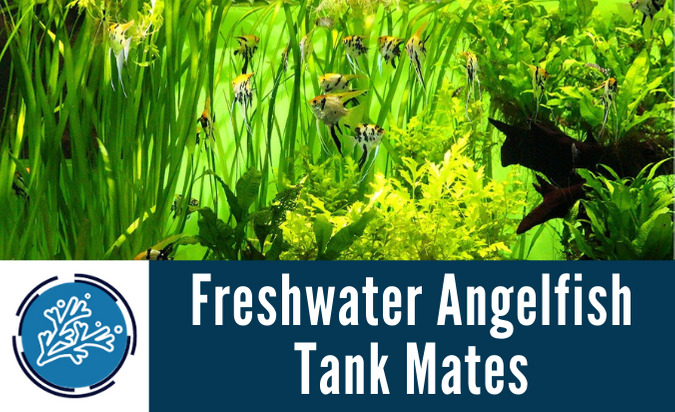
Many people say that freshwater angelfish should be kept together in a tank with no other fish, however wild angelfish live in areas with a high biodiversity and share their home with various other fish species. Angelfish are not generally aggressive towards other fish; however, they can be seen bullying each other. It is still best to house your angelfish in a large group as they will feel more comfortable in their enclosure with their own kind.
Angelfish can be housed with peaceful and non-aggressive fish, and fish that are very active. Angelfish are slow moving and also consume their food relatively slow, so any fish that will outcompete your angelfish during feeding time will not make a good tank mate. Some compatible tank mates for your angelfish include Black Skirt Tetras, Mollies and Dwarf Gouramis. They will also live well with bottom dwellers such as Plecos, Clown Loach, and Kuhli loach and small freshwater Catfish.
Tank mates to avoid are anything small enough for your angelfish to eat, this includes small tetras. You will also need to avoid fin nippers due to angelfish having such long and delicate fins, this includes Barbs as they are pushy fish who are known to harass other fish and bite at their fins. Guppies could be housed with angelfish; however, this should be monitored closely as some may be small enough to become food, and as they tend to breed rapidly, the angelfish will most likely eat the fry. Angelfish will also nip long fins of other fish, so avoid species such as paradise fish and bettas.
These fish can be housed with other cichlids, however this can be risky as most cichlids are semi-aggressive and territorial. If you are hoping to house other cichlids with your angelfish, we recommend Bolivian Rams, German Blue Rams, or Dwarf Cichlids. You may be able to house Discus fish with your angelfish, however it is risky as the angelfish may be more active than the Discus, and they can begin to cause stress to the Discus. Any other aggressive cichlids need to be avoided, including Oscars and Convicts.
Enrichment
Enrichment is a great way to stimulate your fish and to also add life to the aquarium. This can be done in a few different ways however the most beneficial and popular method is using plants and objects to change the environment, and using new methods of feeding to give them a new experience or replicate what they would do in the wild.
Angelfish can be housed in both a planted tank or a bare tank, and it will not affect them too much. However, a planted tank is always the best option, and they will forage and explore the plants and even through the substrate.
There are several methods of enrichment, these include:
Environmental enrichment – Changing the appearance or function of the aquarium for the fish to experience a new environment. This also includes installing Aquarium LEDs into the tank.
Food enrichment – Using new foods to allow them to use different feeding methods
Social enrichment – Adding compatible species to the aquarium to give the fish company and new interactions
Regarding environmental enrichment, angelfish will benefit from any plants that require similar care needs in terms of water temperature and conditions. Plants such as Java Fern will give your angelfish the chance to explore between the tall and textured leaves, replicating what they would experience in the wild. These fish do occasionally forage through the substrate, so adding in some Java Moss is a great way to add variety and texture to the substrate for the fish to explore, this moss will also grow over any rocks or objects in the aquarium which creates a natural environment.
As angelfish are native to rivers in South America, they would be found in dimly lit areas where overhanging trees block out the light, so a great way to replicate this is to add in some floating plants or a dim light system. Having a planted tank usually results in some leaves floating to the surface when they are fallen from the plant, but adding some plants dedicated to the surface of the water will have a greater effect on the light.
Angelfish Breeding
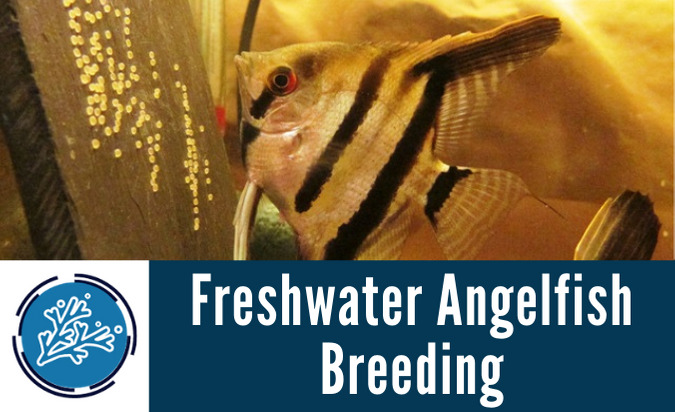
One of the many benefits of owning angelfish is that they’re easy to breed, when given the correct breeding environment they will often separate into pairs ready for breeding. As they are quite difficult to sex, this separation is the easiest way to tell them apart, as a male and female will stay together and away form all of the other fish. So, the best way to choose your pair is to house at least 5-6 angelfish and let them separate themselves into pairs once they reach adulthood. Once this occurs you can then move them into a separate breeding tank.
In order to breed them successfully, you will need:
- A separate 20 gallons tank
- A low flow filter
- Slanted surfaces – pipes, tiles or sturdy plants
The water temperature should be maintained at 82 degrees Fahrenheit, and the pair should be fed 4 times a day with live food such as tubifex worms, they can also be fed on fish flakes that are high in protein.
How many eggs to Angelfish lay?
When the female is ready to lay her eggs, she will spend most of her time at the surface of the water. Angelfish can lay around 200-400 eggs at a time, but a successful spawn can cause up to 1000 eggs to be laid the male then fertilizes them once they are laid. The first few spawns can be unsuccessful as the adults can end up consuming the eggs, but after time and patience your angelfish will adapt to it and raise their offspring. A large number of the fry also won’t make it to adulthood due to deformities from poor genetics or physical harm from when they were in the eggs.
The eggs will hatch in 2-3 days and are dependent on their parents to keep them safe once they have hatched into fry that can’t yet swim freely by themselves. The adult angelfish will often carry the newborn fry around the tank with their mouths.
Once the fry are more independent, they can be given crushed up pieces of fish flakes, or baby brine shrimp.
Common health issues in Angelfish
The most common issue seen in angelfish are parasitic infections, one being Nematode (roundworm) infection. This infection is spreadable and will be passed on to other fish in your aquarium if it occurs.
This is caused by your angelfish eating the parasites eggs or larvae which can occur in unclean tanks around uneaten food, this is usually if the aquarium has been neglected and hasn’t been cleaned out frequently enough or correctly; or if the filter has stopped working correctly and hasn’t removed any harmful substances or bacteria form the water.
This infection has a three month period where the worm lives inside the fish, the worm takes the nutrients that the fish consumes and overtime this will make the fish weak and no longer able to survive.
Signs and symptoms include:
- Inflammation
- Significant weight loss
- Stunted growth
- Cysts
- Lethargy
- Abnormal behaviors and swimming
If any of the symptoms arise, it is important to take the infected fish out of its aquarium immediately and placed into a smaller isolation tank. You should also ensure that the aquarium is thoroughly cleaned and a large water change carried out to eliminate any parasite eggs or larvae.
To treat this infection, you can use any worming treatments for tropical fish, if you are looking to treat this infection from home, we recommend trying the following products:
Angelfish are also susceptible to another parasite known as Hexamita, this parasitic infection is common in all cichlids. It is caused by a protozoan being consumed and going into the fish’s bladder and intestines.
Signs and symptoms include:
- Discoloration
- Significant weight loss
- Abnormal behavior and lethargy
This parasite also occurs in dirty water and uncleaned tanks, so ensure your aquarium is properly cleaned at least once every 2 weeks. Parasites also thrive in cooler water, so ensure that your angelfish are kept at the correct temperature, as all fish become more susceptible to infections and diseases when kept in cold water.
Are Angelfish the right fish for you?
Angelfish are a delight to own and are popular throughout the aquatic industry. The ‘King of the Aquarium’ proves its name with its beauty and eye catching qualities, with a variety of colors and patterns to choose from they make a great statement to an aquarium. Even though they are a great addition, they belong to the cichlid family and can carry out aggressive behaviors, however they are one of the most peaceful cichlids out there.
Angelfish can be suitable for beginners as long as you do your research and are knowledgeable on their behaviors and requirements, ensure that they are housed in the correct environment with compatible species and they will fit perfectly in your home.

